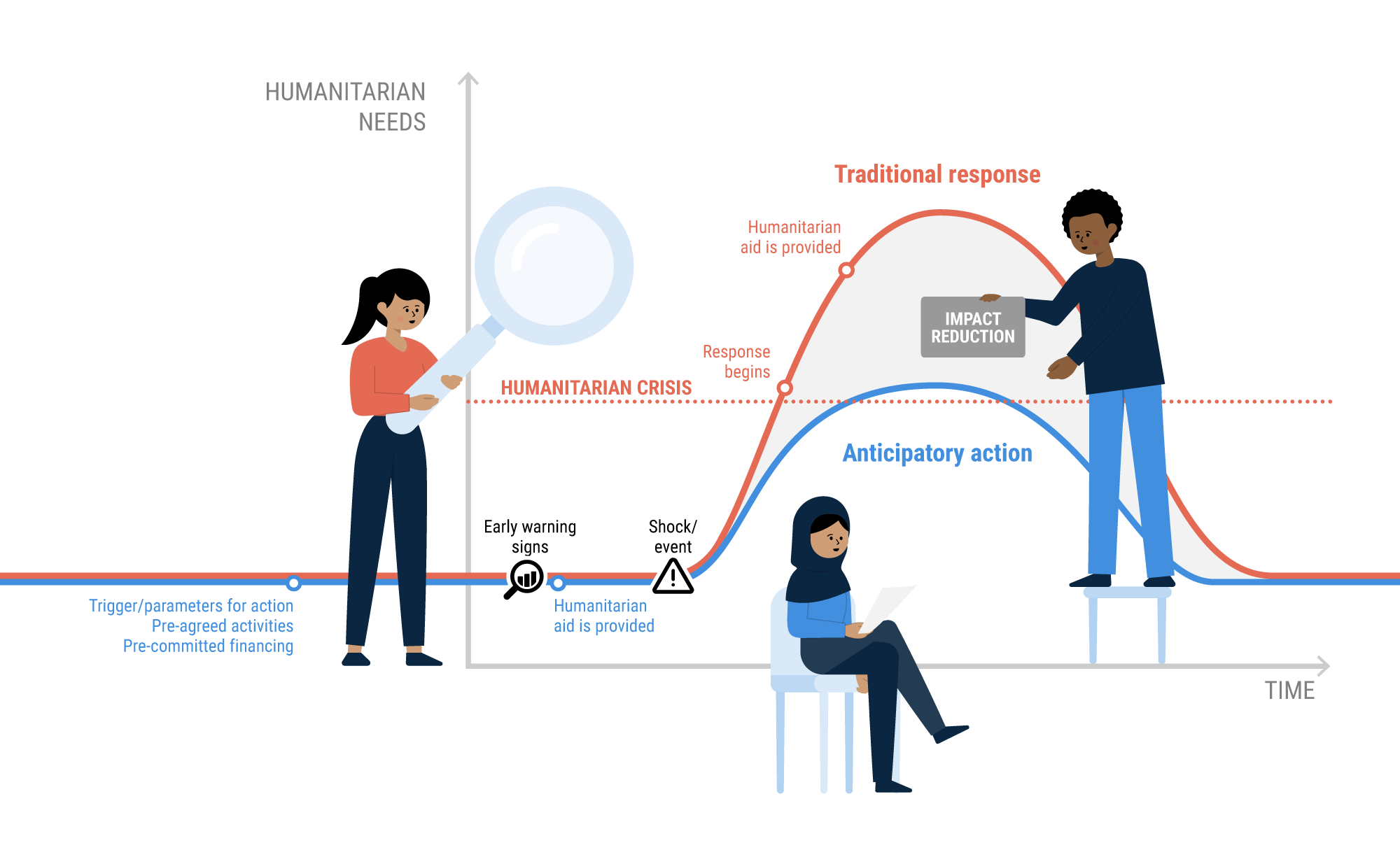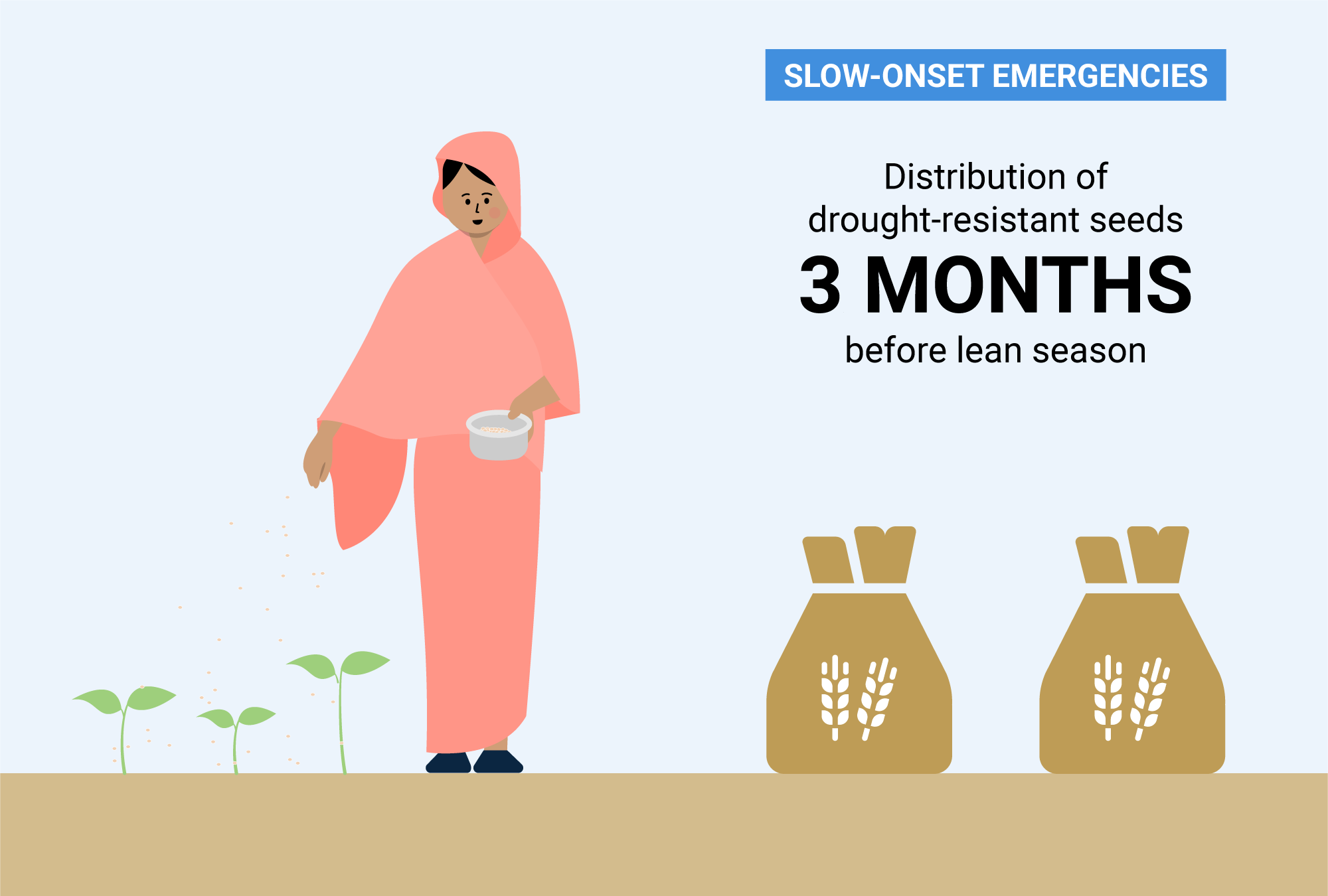Menu
Anticipatory action is fundamentally different from humanitarian response and development programming. Anticipatory humanitarian actions are those actions taken in advance of a crisis, before either the shock or its peak impact. Therefore, anticipatory action makes acting the default when risks, not needs, increase.



This works differently in rapid–onset emergencies, where the window of opportunity to act is extremely short compared to a slow-onset situation. For example, giving people cash 10 days before a looming flood involves a different level of operational readiness compared to, say, distributing drought-resistant seeds three months before the start of a lean season that is projected to be extremely dry. In both cases, though, missing the window of opportunity might render the value and nature of anticipatory interventions obsolete.
An anticipatory action pilot involves implementing a formal mechanism at the country level called an anticipatory action framework or plan. This predetermines who gets how much money, to do what, based on which signal so that a problem can be caught before it becomes a crisis.
The objective of anticipatory actions is to mitigate the peak impact of the shock. Therefore, these actions are implemented only if there is a high probability of such a shock occurring and peaking, and if the implementation is extremely time critical.
Anticipatory action therefore requires proactive measures to get ahead of major shocks to mitigate their potential impacts on vulnerable populations.
Three core components of anticipatory action are designed to maximize the speed and effectiveness of interventions:
If the answer to any of these questions is no, then anticipatory action does not currently make sense for that specific disaster. Other options should be explored.
If the answer to all questions is yes, then further assessment of the potential scope and scale of an anticipatory action plan can be carried out.
Anticipatory action frameworks are developed and implemented in a consultative and participatory manner.
The Resident Coordinator/ Humanitarian Coordinator (RC/HC), supported by OCHA/the RC Office (RCO) convenes, leads and facilitates the process from planning to design, implementation, and monitoring and evaluation.
The process is anchored in an anticipatory action core team in country, comprising representatives of technical focal points from interested agencies who are willing and able to invest in an anticipatory action framework. The team will regularly update Humanitarian Country Teams, Sectors/Working Groups, and Inter-Cluster Coordination Group on their work.
During the pilot period, cross-divisional OCHA roll-out teams have been deployed to work collaboratively across OCHA and with RC/HCs, country teams, RCOs, governments and partner organizations to develop anticipatory action frameworks for specific hazards in different countries and regions. Once established, the ownership of the frameworks rest with the RC/HC, supported by OCHA.
Guided by the RC/HC, the core team is key in taking the pilot through the ABC steps of anticipatory action.
Partners represented by the relevant technical focal points contribute to the design and implementation of the anticipatory action framework.
The core team:
At all stages of the process, the anticipatory action core team works with an OCHA team comprising country and headquarters staff.
Duty stations can experience a high turnover of staff. But when staff leave, they take their knowledge with them. Consider how information and agreed actions can be shared and retained, so that anticipatory action plans remain intact even if core team members depart.
Concept notes define and identify the shock. They provide a sense of who can do what, when and with which resources. Before the anticipatory action is established, the concept note is a key guiding document for the pilot team, providing the rationale and approach for anticipatory action in a country.
This section provides examples of concept notes and a template that could be used for future pilots.
For more information on learning, see the section on learning and evaluation.
Service provided by
OCHA coordinates the global emergency response to save lives and protect people in humanitarian crises. We advocate for effective and principled humanitarian action by all, for all.
Except where otherwise noted, content on this site is licensed under a Creative Commons by 4.0 International license.